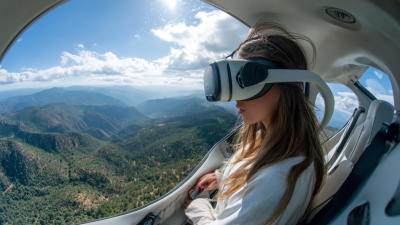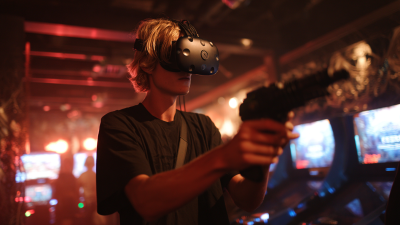Digital Best Innovations in VR Flight Simulation Technology
Table of Contents
- Innovative Hardware Advancements in VR Flight Simulators
- Realistic Environmental Modeling Techniques in Flight Simulation
- User Experience Enhancements Through Haptic Feedback Technology
- Integration of AI and Machine Learning in Flight Simulations
- Cross-Platform Compatibility and Accessibility in VR Flight Training
- Emerging Trends: Multiplayer and Social Aspects in VR Flight Simulators
- FAQS
- Conclusion
- Related Posts
In recent years, the advancements in VR technology have revolutionized various industries, particularly in the aviation sector, where the emergence of the VR Flugsimulator has transformed flight training and simulation practices. As one of the pioneers in this field, Guangzhou Longcheng Electronic Co., Ltd., through its brand VART VR, has been at the forefront of developing cutting-edge VR flight simulation technology. Located in Guangzhou and spanning an impressive 8000 square meters, our facility houses a dedicated team of over 60 professionals who specialize in delivering innovative VR solutions. Our commitment to excellence and a one-stop service model for VR or cinema projects positions us as a key player in the industry. In this article, we will explore some of the best digital innovations in VR flight simulation technology, highlighting their impact on training efficacy and user experience, and showcasing how companies like VART VR are shaping the future of aviation training.

Innovative Hardware Advancements in VR Flight Simulators
The realm of virtual reality (VR) flight simulation technology has seen significant advancements in hardware over recent years, revolutionizing the way enthusiasts and professionals experience flying. One of the most notable innovations is the development of high-resolution headsets that provide an immersive visual experience, allowing users to feel as though they are truly airborne. The introduction of augmented lens technology enhances clarity and reduces motion sickness, which has historically been a concern for many users.
Moreover, the integration of haptic feedback systems in VR flight simulators has profoundly improved user interaction. These systems simulate the physical sensations of flight, enabling pilots to feel turbulence, G-forces, and various control responses in real-time. Coupled with realistic flight yokes and throttle controls that mirror actual aircraft instruments, these advancements create an unparalleled level of realism. As a result, VR flight simulation is not just a leisure activity anymore but is becoming an essential training tool for pilots, offering a cost-effective and safe environment for learning and skill enhancement.
Digital Best Innovations in VR Flight Simulation Technology - Innovative Hardware Advancements in VR Flight Simulators
| Dimension | Description | Advancement Year | Impact Level |
|---|---|---|---|
| Display Technology | Higher resolution headsets with wider field of view. | 2023 | High |
| Motion Tracking | Precision motion tracking systems for realistic control. | 2022 | Medium |
| Haptic Feedback | Advanced haptic feedback systems to simulate physical sensations. | 2023 | High |
| Audio Technology | Immersive spatial audio systems for realistic sound environments. | 2021 | Medium |
| Connectivity | Wireless connectivity for enhanced mobility during simulations. | 2023 | High |
Realistic Environmental Modeling Techniques in Flight Simulation
The integration of realistic environmental modeling techniques has significantly enhanced the capabilities of VR flight simulation technology. By employing advanced algorithms and high-fidelity graphics, developers can create immersive environments that replicate real-world conditions, from dynamic weather patterns to intricate terrain features. These sophisticated modeling techniques allow pilots to experience varied scenarios, such as navigating through thunderstorms or landing in challenging mountainous areas, providing a comprehensive training regime.
Moreover, the use of procedural generation in environmental modeling offers a diverse range of landscapes and scenarios, ensuring that each flight simulation experience is unique. This not only keeps training sessions engaging but also prepares pilots for unexpected situations they may encounter in real flight. Innovations in artificial intelligence also play a critical role, as they can simulate realistic behaviors of other aircraft and wildlife, further enhancing the authenticity of the simulation. As VR flight simulation continues to evolve, these realistic environmental modeling techniques will be crucial in delivering highly effective and immersive training solutions for aspiring pilots.
Digital Best Innovations in VR Flight Simulation Technology
This chart displays the advancements in realistic environmental modeling techniques used in flight simulation technology from 2018 to 2023.
User Experience Enhancements Through Haptic Feedback Technology
The integration of haptic feedback technology into virtual reality (VR) flight simulation is paving the way for unprecedented user experience enhancements. As the global haptic technology market is projected to expand from $3.67 billion in 2025 to $9.27 billion by 2032, with a compound annual growth rate of 14.2%, companies are increasingly investing in research and development to refine this technology. The advancements allow for more immersive interactions as users can feel realistic sensations that mimic real-life experiences, making flight simulations far more engaging and true to life.
Innovative wearable haptic devices are at the forefront of this evolution, enabling users to receive tactile feedback that enhances the virtual environment. Techniques such as vibration and pressure simulation are being employed to bridge the gap between human-machine interaction. As seen with developments showcased at CES 2025, the ongoing advancements in haptic technology not only aim to transform entertainment and gaming industries but also to facilitate rehabilitation processes and improve communication for those with disabilities. This convergence of technology holds the potential to redefine how individuals interact with digital scenarios, creating a richer and more synergistic experience in virtual reality flight simulations.
Integration of AI and Machine Learning in Flight Simulations
The integration of artificial intelligence (AI) and machine learning into flight simulation technology has revolutionized the way pilots train and prepare for real-world flying scenarios. By harnessing vast amounts of data from previous flights and pilot behaviors, AI algorithms can create more adaptive and realistic training environments. This technology allows flight simulations to evolve and respond to individual pilot needs, enhancing both the effectiveness and efficiency of the training process. Simulators can now present dynamically changing scenarios that mimic unpredictable situations, providing pilots with experience in handling emergencies and complex flight conditions.
Moreover, machine learning enables continuous improvement of simulation experiences by analyzing the performance of trainees. As flight schools and airlines incorporate these innovations, they benefit from more personalized feedback and targeted training adjustments. The AI system learns from each session, refining its insights and recommendations for the pilot. This evolution in VR flight simulation not only enhances training but also decreases the time needed for pilots to achieve competence, ultimately leading to safer skies and more skilled aviators.
Cross-Platform Compatibility and Accessibility in VR Flight Training
The advancements in VR flight simulation technology have significantly boosted cross-platform compatibility and accessibility in aviation training. According to the latest report by Research and Markets, the VR flight simulation market is projected to reach $2.5 billion by 2026, driven largely by the demand for more integrated training solutions that work seamlessly across different devices and platforms. This cross-compatibility enables flight schools and training institutions to leverage VR technology without being confined to specific hardware, promoting wider adoption and maximizing resource efficiency.
For aspiring pilots, having access to training modules that work on various operating systems and devices is essential. This approach not only enhances learning opportunities but also caters to a diverse array of learners. A study by the International Society of Aviation Training pointed out that 78% of trainees benefit from VR simulations that allow them to practice on familiar platforms, which increases their retention and competency levels significantly.
Tips: When selecting a VR flight training program, ensure it supports multiple devices to maximize accessibility. Additionally, consider incorporating social elements, such as shared sessions or multiplayer environments, where trainees can collaborate and learn from each other, making the experience more engaging and effective.

Emerging Trends: Multiplayer and Social Aspects in VR Flight Simulators
The landscape of virtual reality (VR) flight simulation technology is evolving rapidly, with a significant emphasis on multiplayer and social interactions. According to a recent report by Mordor Intelligence, the global VR market for gaming, which includes flight simulators, is projected to reach $45.09 billion by 2025, growing at a CAGR of 30.5%. This growth is largely driven by the increasing demand for immersive experiences that allow users not only to navigate through digital skies alone but also to engage with other players in complex scenarios, enhancing the realism and excitement of flight simulation.

Emerging trends show that developers are integrating multiplayer functionalities to create a sense of community among flight sim enthusiasts. Platforms like Microsoft Flight Simulator have incorporated online functionalities that allow players to fly together, share virtual airspace, and participate in group missions. Furthermore, a recent survey by PTC indicated that 62% of VR users expressed a desire for more social features in their gaming experiences. This highlights the critical role multiplayer aspects play in enhancing user engagement, fostering collaborative experiences, and bridging the gap between casual gaming and professional flight training. As these trends continue to unfold, the future of VR flight simulators appears not only to be about individual mastery of flight but also about building vibrant, interactive communities.
FAQS
: Haptic feedback technology provides tactile sensations that mimic real-life experiences, allowing users to feel realistic interactions within the virtual environment, making flight simulations more engaging and immersive.
The global haptic technology market is projected to grow from $3.67 billion in 2025 to $9.27 billion by 2032, at a compound annual growth rate of 14.2%.
Wearable haptic devices allow users to receive tactile feedback through techniques like vibration and pressure simulation, enhancing the realism of virtual environments and overall user experience.
Cross-platform compatibility allows training solutions to work seamlessly across various devices, promoting wider adoption, maximizing resource efficiency, and enhancing learning opportunities for aspiring pilots.
By providing training modules that operate on various operating systems and devices, VR simulations cater to a diverse array of learners, thus increasing retention and competency levels.
According to a study by the International Society of Aviation Training, 78% of trainees benefit from VR simulations that allow them to practice on familiar platforms.
Users should ensure the program supports multiple devices for accessibility and may also incorporate social elements like shared sessions or multiplayer environments for collaborative learning.
Haptic technology is also being used to facilitate rehabilitation processes and improve communication for individuals with disabilities, showcasing its versatility beyond entertainment and gaming.
Conclusion
The article "Digital Best Innovations in VR Flight Simulation Technology" explores the latest advancements that are shaping the future of VR flight simulators. It highlights innovative hardware developments that enhance realism and immersion, alongside sophisticated environmental modeling techniques that create lifelike flying experiences. User experience is further elevated through haptic feedback technology, making virtual flight more engaging than ever. The integration of AI and machine learning plays a pivotal role in enhancing simulation accuracy and responsiveness, while cross-platform compatibility ensures that VR flight training is accessible to a broader audience. Emerging trends in multiplayer and social interactions within these simulators are also considered, indicating a shift towards community-centered experiences in VR flight simulation.
As a leading VR simulator manufacturer, Guangzhou Longcheng Electronic Co., Ltd. (VART VR) is at the forefront of these innovations, providing comprehensive solutions in VR technology. With extensive expertise and a commitment to quality, VART VR is well-positioned to support the evolving needs of VR flight simulation, continually enhancing the capabilities of the VR Flugsimulator for users around the world.
Related Posts
-

How to Elevate Your Business with Vr Flight Solutions
-

Ultimate Guide to Choosing the Right Virtual Reality Machine for Your Business
-

The Future of Immersive Experiences with VR Chairs
-

Innovative Solutions for Enhancing VR Experience with the Next Generation VR Chair 360
-

What Makes VR Arcades a Revolutionary Experience in Entertainment
-

How to Choose the Perfect VR Motorbike Simulator for Your Business Needs

